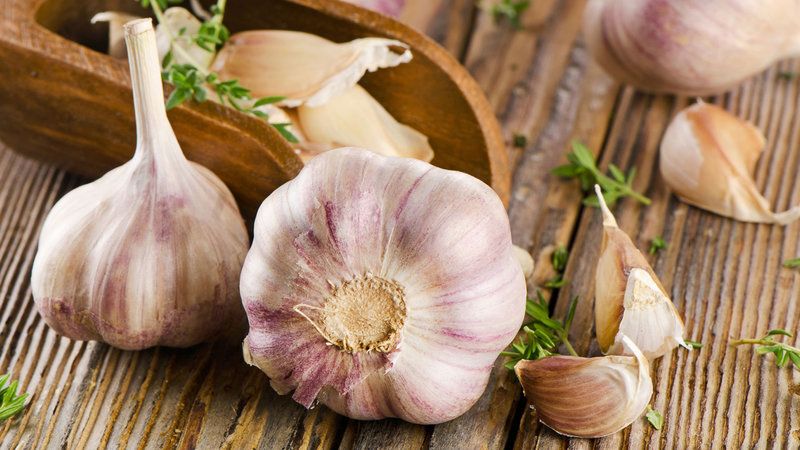Is
eating raw garlic good for you? Garlic has the ability to brighten up any dish and, in addition, it is an ingredient that has been associated with health benefits since ancient times.
Many of our dishes would lose their flavor without the flavor of garlic, a bulb-shaped plant similar to chives, leeks, or onions.
One of the differences between garlic and other bulbs is its appearance: the garlic bulb is covered with several layers of paper-like skin that, when peeled, reveal up to 20 small edible bulbs, the garlic cloves.
Garlic in Ayurveda
According to Ayurveda, garlic (Lashuna) possesses five tastes, sweet, sour, pungent, bitter and astringent (pancharasa). It doesn’t possess the salty taste. The ancient Indian Ayurvedic physician Kashyapa said that garlic is born from nectar. What he meant was, it has a rejuvenating (rasayana) property. This herb clears the channels (srotas), produces sperm and spermatic fluid (shukra) along with ovum and ovarian hormones (shonita).
Allicin, its star ingredient
But talking about garlic is not just a simple kitchen seasoning and its peculiar shape. Interest in garlic and its potential benefits has its roots in ancient times. It is one of the first plants used for the treatment of diseases, even biblical references to garlic have been found .
This food is also particular for its smell and taste. Whole garlic contains a compound called alliin. When crushed, cut, or grated, this compound turns into allicin, the main active ingredient in garlic. Allicin contains sulfur, which is what gives it its distinctive smell and taste. It is found at its maximum strength in fresh, raw garlic cloves.
However, allicin is unstable, so it is quickly converted to other sulfur-containing compounds that are believed to give garlic its medicinal properties. The antimicrobial, hypolipidermic, antioxidant, and antithrombotic effects attributed to garlic are believed to be primarily related to allicin.
Is Eating Raw Garlic Good For You
A raw garlic clove (about three grams approximately) contains, according to the nutritional database of the United States Department of Agriculture (USDA), 4.5 calories; one gram of carbohydrates; 5.4 milligrams of calcium; 0.9 milligrams of vitamin C; 0.2 grams of protein; and 0.1 grams of fiber, among other nutrients.
Thanks to the sum of all these main nutrients and allicin, garlic is attributed to several properties :
1. Antibacterial and antifungal properties : A garlic compound, diallyl sulfide, is 100 times more effective than two antibiotics (erythromycin and ciprofloxacin) in fighting the bacteria Campylobacter sp ., One of the most common causes of intestinal disease.
2. Antiviral Properties : Anecdotal evidence also suggests that it has antiviral properties thanks to the presence of selenium, which has been shown to inhibit the spread of viral infections.
3. Digestive : garlic, in the right amount, improves the secretion of stomach juices and, thanks to its antiseptic properties, helps some stomach and digestive diseases. This is because they contain prebiotics, compounds that feed the microorganisms in fermented foods (the well-known probiotics ) and help maintain intestinal health.
4. Helps control high blood pressure : Garlic's ability to reduce high blood pressure would be similar to standard medication, according to a study published in 2014 according to which the polysulfides in the spice promote the opening of blood vessels and therefore , lowering blood pressure.
5. Prevention of heart disease : garlic is rich in organosulfur compounds, with the ability to reduce total cholesterol, LDL and HDL, in people with high levels. The American Heart Association (AHA) publishes dietary recommendations to prevent the risk of cardiovascular disease, such as high consumption of fruits and vegetables and whole grain products. It also offers a list of specific foods with some cardioprotective effect. And garlic is one of these foods, along with nuts or legumes.
6. Regarding its possible preventive role against cancer , the National Cancer Institute , although it does not recommend any dietary supplement for cancer prevention, does recognize garlic as one of several vegetables with "possible anti-cancer properties."
How much garlic is recommended to consume
Although the effective dose of garlic is not well determined, a recommended dose of about four grams (one or two cloves) for adults of raw garlic per day is established . The side effects of garlic consumption are generally mild and rare.
Garlic's bad reputation is justified not by keeping vampires away, but by giving off halitosis and bad body odor . An excessive consumption of garlic, especially on an empty stomach, has also been linked to gastrointestinal upset or flatulence .
It has not been shown to have an effect on drug metabolism , although the American Academy of Family Physicians (AFP) suggests that people taking blood thinners be "cautious." Due to its anticoagulant effects, it is recommended to avoid consuming large amounts of garlic before and after surgery.
How to get the most out of garlic
The way garlic is processed or prepared significantly changes the way we can benefit. It is worth remembering that the best way to fully benefit from the qualities of garlic is to eat the garlic clove when it is raw or undercooked , before the valuable enzymes and nutrients are denatured by the heat of cooking.
The enzyme alliinase, which converts alliin to allicin, only works under certain conditions. It has been shown, for example, that 60 seconds in the microwave or 45 minutes in the oven can deactivate allinase .
Instead, crushing the garlic and letting it sit for 10 minutes before cooking can help prevent the loss of its nutritional properties. For experts, the loss of benefits caused by cooking can be offset by increasing the amount of garlic used.









0 Comments